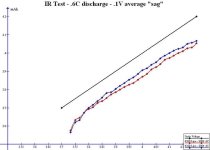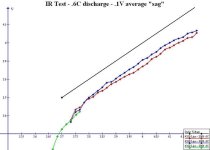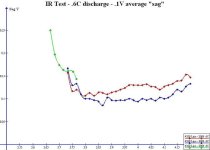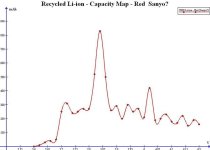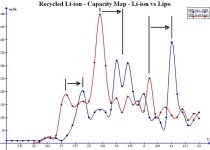DrkAngel
1 GW
I modded a 5V 30A Meanwell for 4.2V charging. Ganged together batches of 40p and charged-equalized. Making sure to monitor for any cells heating up and removed them as defective.John in CR said:DrkAngel,
When I was building packs using recycled cells, for matching them I tested large numbers of them at once to determine relative capacity. They were blocks of 2p cells with each 2p nominally 3ah. I paralleled all of the same size blocks to charge all cells to an identical voltage. Then I connected them all in series and using a series string of incandescent light bulbs I discharged 2ah. Then I separated them and measured their ending voltage and assigned a grade to each block of cells. Those with the highest voltage had the highest capacity and got an A grade for example.
Separated and let set for several days, removed any with significant self-discharge.
Then capacity tested.
Latest methods:
See - Bulk Capacity Testing
"Method One"
I ran 30s ~120V through 2p - 60w light bulbs which drains 1 amp.
Each hour of discharge = 1000mAh of capacity. Similarly, I monitored cells, removed a few after 2 1/2 hours 2500mAh, stopped discharge on the rest at 3 hours (3000mAh), then graded the cells by remaining voltage as fair, good, very good and excellent.
"Method Two"
Is similar except I added a Ah meter and withdrew cells when they reached "optimal DOD" 3.7V (3.3V under 1A drain). This allowed precise mAh rating for each pair. Of course this required continuous monitoring during the last 2 hours. I did use a 3 wire type meter (separate battery for meter) so that meter retained readings when disconnected.
(18s on 1st test, but designed for 30s 30 pairs = 60 cells.)
2 100w light bulbs (2A) for faster process ... better to drop back to one bulb (1A) when cells start nearing empty, cells drop voltage quickly when near "empty" (3.5V?) and can heat up dangerously!
IR (Internal Resistance)
I began running a comparative IR test on all cells.
Easiest was with the Lipo 6packs 3s2p, I merely applied a 2.5A 12V fan to 12.3V 4.32Ah pack and subtracted voltage of pack after fan attained full speed, from original voltage. Comparative IR varied from .5V to 1V. Cells were discharge tested in batches of similar IR.
Any identically applied discharge of ~.5C should give a good "comparative IR".
Note: While a valuable consideration, IR proved to be a very poor indicator of cell capacity!
Improvements?
2 100w ligt bulbs (~2 Amp discharge)
2 sets of 30s discharging at a staggered time, necessitating minimal attention to one string when other requires constant. Can be overlapped and process several strings of 30s in one prolonged session. Test can be delayed-stopped at any time then resumed later, independent battery for meter retains mAh discharged.




